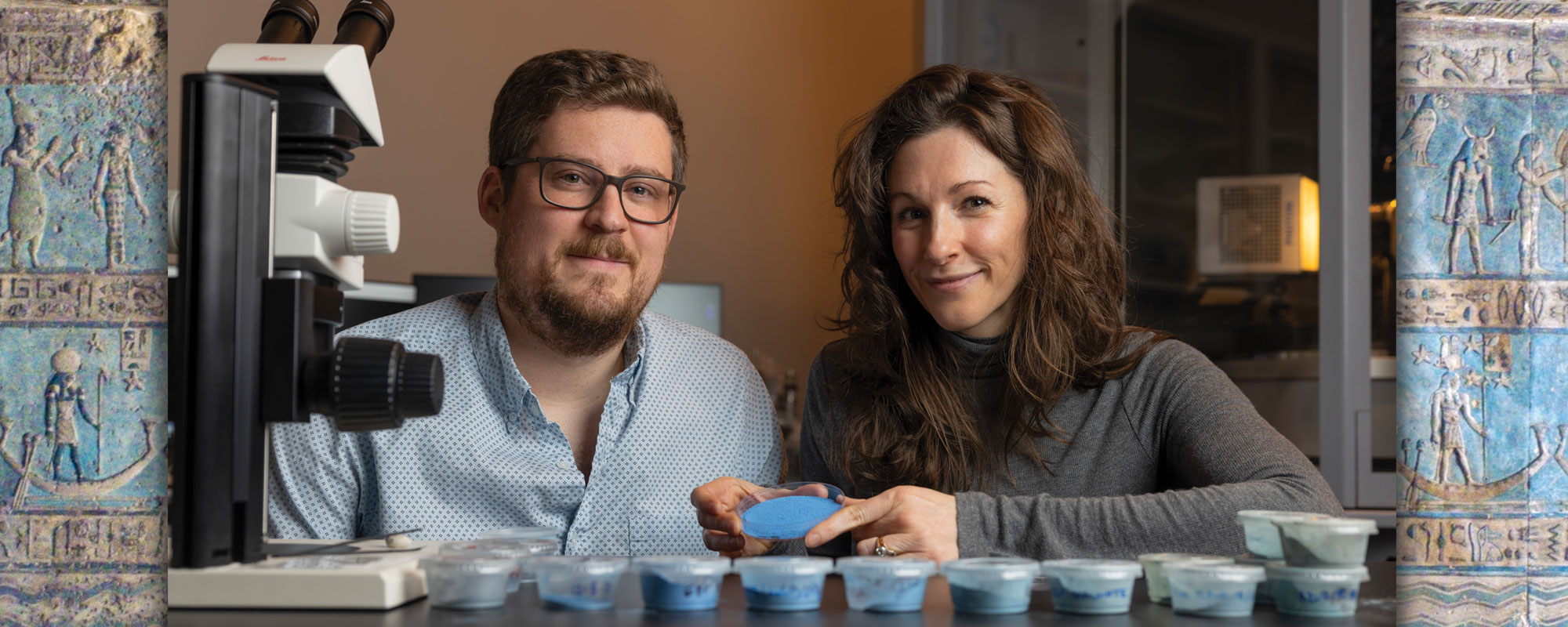Imagine stepping out into the brilliant sun of ancient Egypt, a cloudless azure sky stretching toward the horizon. In the distance, the Nile River winds its way toward the Mediterranean, coursing by in its own silt-laden shade of blue.
These were the natural surroundings that inspired the creation of the world’s first synthetic pigment, Egyptian blue, some 5,000 years ago. It was used to adorn statues, coffins, paintings, and pottery, adding a bright shock of color to contrast the pervasive natural tones of ochre and burnt umber. But over the millennia that followed, the process used to make Egyptian blue was lost. There is no recipe detailing the exact materials or the time and temperature required to make the powder used as the pigment’s base.
The historical weight of this particular hue and the questions around its creation beckoned Lisa Haney and Travis Olds, an Egyptologist and mineralogist, respectively, at Carnegie Museum of Natural History. Together they stepped back in time to explore the synthesis of Egyptian blue for a pair of upcoming exhibitions.
“Often when people think about ancient peoples or peoples from the past they imagine them as less scientifically advanced than us,” Haney says. “Part of this is about understanding how we think about producing goods and technology from different perspectives.”
The work to recreate Egyptian blue will be highlighted in The Stories We Keep, an exhibition set to open in October 2023, focused on the museum’s conservation of objects from ancient Egypt. Farther down the line, another exhibition, Egypt on the Nile, will delve into the materials that defined the ancient world and how they were produced as part of a larger exploration of humans’ connection to the natural world. For Haney, researching Egyptian blue was an opportunity to explore how Egyptians utilized and interacted with the natural resources and elements available to them.
Most ancient pigments were derived from natural resources-—ochre, charcoal, or lime, for example. And, in some cases, Egyptians were able to use lapis lazuli, a metamorphic rock that was only found in Afghanistan, to represent the color blue. But because importing it to Egypt was “cost-prohibitive and completely impractical” for everyone but royalty, Haney says, Egyptians devised a process to emulate its intense ultramarine hue. Without a consistent way to represent the beautiful blues of the world around them, they had to get creative.
“This was something that had to be invented to fill a hole that existed,” Haney says.
To try their hand at reimagining that process, Haney and Olds took microscopic samples from three artifacts in the museum: a fragment from a cartouche excavated at the archeological site of Amarna; a footcasing from a mummified person, made of plastered layers of papyrus, or cartonnage, and excavated at the Egyptian village of Sedment; and a painted wooden falcon used to decorate a coffin, excavated at one of Egypt’s oldest cities, Abydos. Then they sent the samples to John McCloy, director of Washington State University’s School of Mechanical and Materials Engineering, with whom Olds conducted postdoctoral research. McCloy worked with under-graduate researcher Julia Esakoff to begin recipe testing.
“How can we use the modern lab, with a quantitative understanding of a mineral’s influence on color, to understand ancient processes or sources of materials?”
– Travis Olds, Assistant Curator Of Minerals & Earth Sciences, Carnegie Museum Of Natural History
Using materials that would have been available in ancient Egypt—calcium carbonate that could have been drawn from limestone or seashells; quartz sand; and a copper source—the researchers prepared nearly two dozen powdered pigments in a stunning range of blues. They were seeking to replicate cuprorivaite, the mineral that gave Egyptian blue such resonance.
To create their samples, they used a mortar and pestle to grind the copper-bearing minerals malachite and azurite into a fine powder, mixed them by hand, and placed them into a furnace at around 1,000 degrees Celsius, which McCloy calls a “modest temperature for what technologies they would have had available at that time.” The color of the emerging powders varied widely, some verging toward gray, others green, some as light as the ocean’s surface and others as dark as its depths.
The researchers’ best powder sample contained roughly 50 percent cuprorivaite, more than enough to deliver a vibrant blue that brought ancient history back to life. They can’t know exactly how Egyptians would have achieved the same end result—“that’s the million-dollar question,” McCloy says—but the research offers a window into a process that carried on for thousands of years.
Haney, Olds, and their team weren’t the first to recreate Egyptian blue in the modern era, but their interdisciplinary approach—combining science and archaeology—gives added weight to what they found.
“Where we differentiate is trying to make that materials-science connection,” Olds says. “How can we use the modern lab, with a quantitative understanding of a mineral’s influence on color, to understand ancient processes or sources of materials?”
By using spectroscopy and X-ray diffraction to analyze samples and develop their own version of Egyptian blue, the researchers transported themselves—and, soon, museum visitors—into an ancient era. Their findings also offer a tangible demonstration of the connections across cultures. After all, the beauty of a bright blue sky is boundless, no matter the time or place.
Receive more stories in your email
Sign upTags:
Science & Nature
